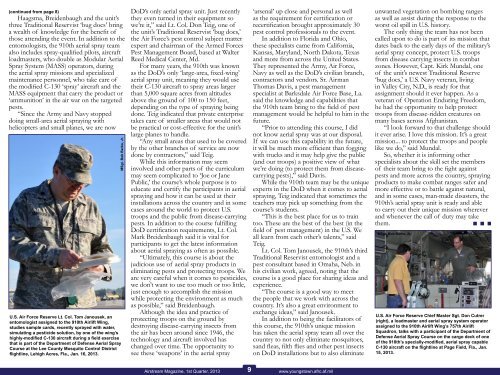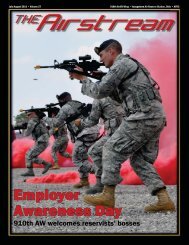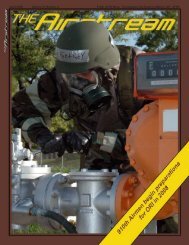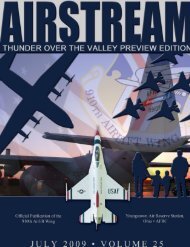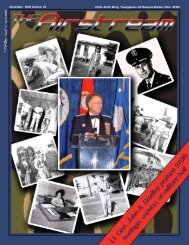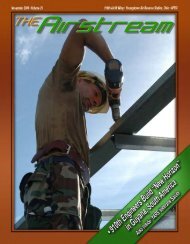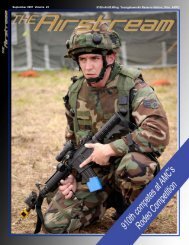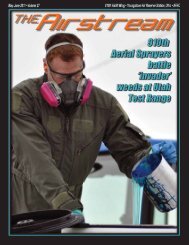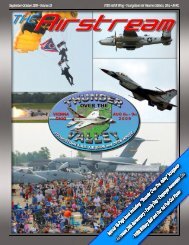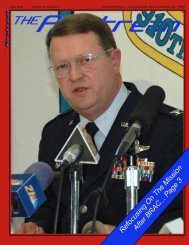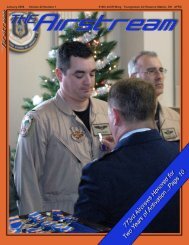Airstream Magazine - Youngstown Air Reserve Station
Airstream Magazine - Youngstown Air Reserve Station
Airstream Magazine - Youngstown Air Reserve Station
Create successful ePaper yourself
Turn your PDF publications into a flip-book with our unique Google optimized e-Paper software.
(continued from page 8)Haagsma, Breidenbaugh and the unit’sthree Traditional Reservist ‘bug docs’ bringa wealth of knowledge for the benefit ofthose attending the event. In addition to theentomologists, the 910th aerial spray teamalso includes spray-qualified pilots, aircraftloadmasters, who double as Modular AerialSpray System (MASS) operators, duringthe aerial spray missions and specializedmaintenance personnel, who take care ofthe modified C-130 ‘spray’ aircraft and theMASS equipment that carry the product or‘ammunition’ in the air war on the targetedpests.“Since the Army and Navy stoppeddoing small-area aerial spraying withhelicopters and small planes, we are nowU.S. <strong>Air</strong> Force <strong>Reserve</strong> Lt. Col. Tom Janousek, anentomologist assigned to the 910th <strong>Air</strong>lift Wing,studies sample cards, recently sprayed with water,simulating a pesticide solution, by one of the wing’shighly-modified C-130 aircraft during a field exercisethat is part of the Department of Defense Aerial SprayCourse at the Lee County Mosquito Control Districtflightline, Lehigh Acres, Fla., Jan. 16, 2013.MSgt. Bob Barko, Jr.DoD’s only aerial spray unit. Just recentlythey even turned in their equipment sowe’re it,” said Lt. Col. Don Teig, one ofthe unit’s Traditional Reservist ‘bug docs,’the <strong>Air</strong> Force’s pest control subject matterexpert and chairman of the Armed ForcesPest Management Board, based at WalterReed Medical Center, Md.For many years, the 910th was knownas the DoD’s only ‘large-area, fixed-wing’aerial spray unit, meaning they would usetheir C-130 aircraft to spray areas largerthan 5,000 square acres from altitudesabove the ground of 100 to 150 feet,depending on the type of spraying beingdone. Teig indicated that private enterprisetakes care of smaller areas that would notbe practical or cost-effective for the unit’slarge planes to handle.“Any small areas that used to be coveredby the other branches of service are nowdone by contractors,” said Teig.While this information may seeminvolved and other parts of the curriculummay seem complicated to ‘Joe or JanePublic,’ the course’s whole purpose is toeducate and certify the participants in aerialspraying and how it can be used at theirinstallations across the country and in somecases around the world to protect U.S.troops and the public from disease-carryingpests. In addition to the course fulfillingDoD certification requirements, Lt. Col.Mark Breidenbaugh said it is vital forparticipants to get the latest informationabout aerial spraying as often as possible.“Ultimately, this course is about thejudicious use of aerial spray products ineliminating pests and protecting troops. Weare very careful when it comes to pesticides,we don’t want to use too much or too little,just enough to accomplish the missionwhile protecting the environment as muchas possible,” said Breidenbaugh.Although the idea and practice ofprotecting troops on the ground bydestroying disease-carrying insects fromthe air has been around since 1946, thetechnology and aircraft involved haschanged over time. The opportunity tosee these ‘weapons’ in the aerial spray‘arsenal’ up close and personal as wellas the requirement for certification orrecertification brought approximately 30pest control professionals to the event.In addition to Florida and Ohio,these specialists came from California,Kansas, Maryland, North Dakota, Texasand more from across the United States.They represented the Army, <strong>Air</strong> Force,Navy as well as the DoD’s civilian branch,contractors and vendors. Sr. <strong>Air</strong>manThomas Davis, a pest managementspecialist at Barksdale <strong>Air</strong> Force Base, La.said the knowledge and capabilities thatthe 910th team bring to the field of pestmanagement would be helpful to him in thefuture.“Prior to attending this course, I didnot know aerial spray was at our disposal.If we can use this capability in the future,it will be much more efficient than foggingwith trucks and it may help give the public(and our troops) a positive view of whatwe’re doing (to protect them from diseasecarryingpests),” said Davis.While the 910th team may be the uniqueexperts in the DoD when it comes to aerialspraying, Teig indicated that sometimes theteachers may pick up something from thecourse’s students.“This is the best place for us to traintoo. These are the best of the best (in thefield of pest management) in the U.S. Weall learn from each other’s talents,” saidTeig.Lt. Col. Tom Janousek, the 910th’s thirdTraditional Reservist entomologist and apest consultant based in Omaha, Neb. inhis civilian work, agreed, noting that thecourse is a good place for sharing ideas andexperience.“The course is a good way to meetthe people that we work with across thecountry. It’s also a great environment toexchange ideas,” said Janousek.In addition to being the facilitators ofthis course, the 910th’s unique missionhas taken the aerial spray team all over thecountry to not only eliminate mosquitoes,sand fleas, filth flies and other pest insectson DoD installations but to also eliminateunwanted vegetation on bombing rangesas well as assist during the response to theworst oil spill in U.S. history.The only thing the team has not beencalled upon to do is part of its mission thatdates back to the early days of the military’saerial spray concept, protect U.S. troopsfrom disease carrying insects in combatzones. However, Capt. Kirk Mundal, oneof the unit’s newest Traditional <strong>Reserve</strong>‘bug docs,’ a U.S. Navy veteran, livingin Valley City, N.D., is ready for thatassignment should it ever happen. As aveteran of Operation Enduring Freedom,he had the opportunity to help protecttroops from disease-ridden creatures onmany bases across Afghanistan.“I look forward to that challenge shouldit ever arise. I love this mission. It’s a greatmission... to protect the troops and peoplelike we do,” said Mundal.So, whether it is informing otherspecialists about the skill set the membersof their team bring to the fight againstpests and more across the country, sprayingproducts to make combat ranges safer andmore effective or to battle against natural,and in some cases, man-made disasters, the910th’s aerial spray unit is ready and ableto carry out their unique mission whereverand whenever the call of duty may takethem.MSgt. Bob Barko, Jr.U.S. <strong>Air</strong> Force <strong>Reserve</strong> Chief Master Sgt. Don Cutrer(right), a loadmaster and aerial spray system operatorassigned to the 910th <strong>Air</strong>lift Wing’s 757th <strong>Air</strong>liftSquadron, talks with a participant of the Department ofDefense Aerial Spray Course on the cargo deck of oneof the 910th’s specially-modified, aerial spray capableC-130 aircraft on the flightline at Page Field, Fla., Jan.15, 2013.<strong><strong>Air</strong>stream</strong> <strong>Magazine</strong>, 1st Quarter, 20139www.youngstown.afrc.af.mil


